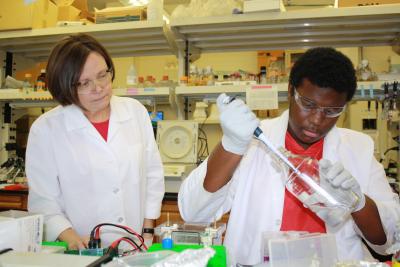Southern Miss Professor Mentors Oak Grove Senior to Medal in Competition
Thu, 10/13/2011 - 11:04am | By: Tara Burcham

When University of Southern Mississippi Professor Sabine Heinhorst began mentoring Oak Grove High School distinguished scholar Nickolas Whitehead, she had no idea the tutelage would help him earn a bronze medal from an international competition.
Whitehead, a senior at Oak Grove, traveled to Houston, Texas to participate in the International Sustainable World (Energy, Engineering and Environment) Project Olympiad – also known as I-SWEEEP – and won the bronze medal in the Energy category, awarded to those scoring in the top 30 percent of competitors.
“This is my first time competing at I-SWEEEP and I was excited to have the opportunity,” said Whitehead. “I enjoyed meeting new people from across the globe and seeing friends from previous science competitions.”
Heinhorst serves as chair of the Department of Chemistry and Biochemistry at Southern Miss. Her work with the distinguished scholar at Oak Grove student is part of the university's community outreach efforts which include a commitment to mentor and engage K-12 students.
Whitehead's entry was part of a multi-year research project: “Creating a CsoS1A-GFP Construct” under Heinhorst's mentorship. He said the project involved working with carboxysomes, protein structures found in many bacteria that remove carbon dioxide from the atmosphere and turn it into cellular material.
The goal of the project is “to create a CsoS1 carboxysome protein that has been modified with a fluorescent protein,” said Whitehead. “When it is fluorescently modified, researchers would be able to identify the protein in the bacteria and in the carboxysomes themselves.”
And while that may sound a bit confusing, Whitehead insists the opposite is true. “The key of the research is the fluorescent properties of the modified protein,” he said.
The I-SWEEEP competition concentrates on research into living in sustainable ways. This research could “potentially create a solar cell coating with the fluorescently modified protein to determine if the fluorescence of the protein affects the output of the solar cell,” said Whitehead.
Finalists were selected to compete at I-SWEEEP by winning a top prize at regional, state or national level science fairs. “Nick was selected because he won first place in the biochemistry division at the Regional Science Fair and was an alternate for the International Science Fair,” said Heinhorst.
“Nick was our only representative from the State of Mississippi and one of over 1,000 students from grades 6-12 traveling to the competition,” she noted.
Previously, Whitehead's work with Heinhorst led him to being the only Mississippi representative in the 2010 BioGENEius competition, an annual competition for high school students that recognizes outstanding biotechnology research in health care, agriculture and forestry, food processing, mining and the environment, and forensics.
Whitehead says Heinhorst's mentorship has been invaluable. “She has been extremely helpful and patient with me,” he said. “Over the course of this project and others, she has stayed late in the lab so I could do experiments after school.”
Heinhorst has equal praise for her young apprentice. “Nick has worked very hard on his project and is continuing his research into his senior year,” she said. “We are working on producing large amounts of the recombinant proteins he designed this year and hope to continue this record of success.”
A total of 2,200 projects were registered for the international competition. Of those, only 440 were selected as finalists and invited to the I-SWEEEP Olympiad in Houston. Students hailed from 70 different countries and 43 states, including 370 project supervisors and 267 judges, scientists from United States universities. The weeklong event brings together scientists from K-12 schools, universities, government and the energy industry.
The I-SWEEEP Olympiad has three categories: Energy, Engineering and Environment. A qualified project can compete in only one category. For more information on I-SWEEEP, visit http://isweeep.org/